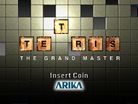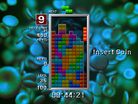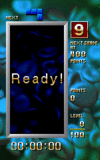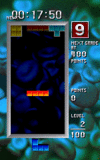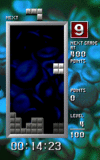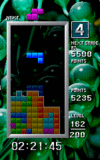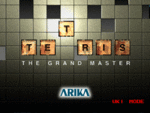Tetris The Grand Master: Difference between revisions
No edit summary |
→Hidden modes: Not sure if this is actually better, let me know please. |
||
| Line 106: | Line 106: | ||
Key: L = Left, D = Down, U = Up, R = Right | Key: L = Left, D = Down, U = Up, R = Right | ||
{| | |||
| | |||
{| | |||
|[[Image:TGM_20G_mode.gif|thumb|100px|none|20G mode]] | |||
|'''20G Mode''' | |||
Immediately enables maximum gravity (20G).<br> | |||
Input code: <code>DDDDDDDDCBA</code> | |||
|} | |||
| | |||
{| | |||
|[[Image:TGM_big_mode.gif|thumb|100px|none|20G mode]] | |||
|'''Big Mode''' | |||
Tetrominoes are twice normal size, simulating play in a 5x10 playfield<br> | |||
Input code: <code>LLLLDCBA</code> | |||
|} | |||
|- | |||
| | |||
{| | |||
|[[Image:TGM_rev_mode.gif|thumb|100px|none|20G mode]] | |||
|'''Rev Mode''' | |||
Play in reverse! Pieces will spawn at the bottom of the playfied and "fall" upwards<br> | |||
Input code: <code>DUUDCBA</code> | |||
|} | |||
| | |||
{| | |||
|[[Image:TGM_mono_mode.gif|thumb|100px|none|20G mode]] | |||
|'''Mono Mode''' | |||
All tetrominoes are monochrome<br> | |||
Input code: <code>RRRUCBA</code> | |||
|} | |||
|- | |||
| | |||
{| | |||
|[[Image:TGM_TLS_mode.gif|thumb|100px|none|20G mode]] | |||
|'''TLS Mode''' | |||
Shows the "Temporary Landing System" aka "ghost piece" for the entirety of the game, not just 0-100<br> | |||
Input code: <code>ABCCBAACB</code> | |||
|} | |||
| | |||
{| | |||
|[[Image:TGM_uki_mode.gif|thumb|150px|none|20G mode]] | |||
|'''Uki Mode''' | |||
A joke mode; instead of line clear sound effect when clearing multiple lines, a child's voice will say "Uki" repeatedly, which is the japanese word for the sound a monkey makes. This is a callback to Sega Tetris, with it's monkey. The child will say "Waaahhh!" instead if you score a Tetris.<br> | |||
Input code: <code>ABABABABABABABABB</code> | |||
|} | |||
|} | |||
=== Other modes === | === Other modes === | ||
Revision as of 01:10, 11 January 2019
| Tetris The Grand Master | |
|---|---|
| Developer(s) | Arika |
| Publisher(s) | Capcom |
| Platform(s) | Arcade |
| Release |
|
| Gameplay info | |
| Next pieces | 1 |
| Playfield size | 10 × 20 |
| Hold piece | No |
| Hard drop | No |
| Rotation system | TGM rotation |
Tetris The Grand Master is an arcade game released exclusively in Japan. It was developed by Arika and is the first game in the TGM series.
Gameplay
TGM's gameplay is heavily inspired by it's arcade predecessor, Tetris (Sega) released 10 years earlier. It uses a modified rotation system, color scheme, and relies heavily on mechanics such as lock delay. Another game which inspired TGM is Shimizu Tetris, a fan game which was the first to introduce 20G gravity.
The main goal in TGM is to score points, awarding the player a higher grade. The game ends when a player reaches level 999. If the player scored enough points, they will be awarded with the grade S9. To achieve the grade GM, the player must also meet some time requirements during play. If the player tops out before reaching level 999, the game ends, awarding the player the current grade and it's "mastering time", the time at which the grade was awarded during gameplay.
Level
Level has a unique implementation in TGM. The level counter will increase by 1 for every piece that enters the playfield. It will also increase by 1 for each line cleared.
When you are about to increment the hundreds digit (e.g., level 399), only line clears will count towards your level. Level 998 is treated similarly, with a final line clear required to reach 999 and finish.
IRS
- Main article: IRS
Abbreviation for Initial Rotation System.
Normally a piece will appear in the rotation showed in the piece preview. With IRS, holding either the left or right rotation button will cause the piece to appear rotated 90 degrees. This allows the player a higher degree of freedom when placing pieces at higher game speeds.
TLS
- Main article: ghost piece
Abbreviation for Temporary Landing System This system is a semi-transparent representation of where the piece will land if allowed to drop into the playfield. It is displayed up to level 100.
Secret grade
- Main article: Secret Grade Techniques
Secret grade is a hidden grading system that recognizes a ">" pattern in the playfield by leaving holes. The first hole becomes Secret grade 9, and each subsequent hole increasing the grade until row 19, the GM grade. The player must top out to have the Secret grade awarded. A minimum grade of 5 is needed to see the message.
Scoring
TGM shares the same scoring gimmicks of many other Tetris games, though they are not quite implemented the same way:
- You receive more points for clearing more lines at once.
- Lines are worth more with each passing level. (The nature of "level" in TGM, however, means the amount of points a line is worth is constantly changing, and especially in the 0-99 section, it is to the player's advantage to stack high before clearing lines.)
- You receive points for forcing a piece down. (Though only when this results in cleared lines, unlike in some other games.)
There are a few scoring gimmicks unique to TGM:
- You receive a combo bonus for clearing lines with consecutive pieces.
- You receive a bravo bonus for clearing the entire screen.
Once one can reach the S9 rank, score becomes irrelevant and the focus changes to a time attack rather than a score attack. Nevertheless, here is the actual scoring formula:
- Score = ((Level + Lines)/4 + Soft) x Lines x Combo x Bravo
Where:
- Level is the current level you are on (before the lines are cleared).
- Lines is the number of lines you just cleared.
- (Level + Lines)/4 is rounded up.
- Soft is the cumulative number of frames during which Down was held during the piece's active time. Note that this means manually locking pieces already on the ground will increase the Soft value by 1.
- Locking a piece without clearing lines sets Combo to 1. Otherwise, the game updates Combo as follows, BEFORE calculating Score:
- Combo = (previous Combo value) + (2 x Lines) - 2
- Example: A double-triple-single combo will have combo values 3, 7, and 7 respectively.
- Bravo is equal to 4 if this piece has cleared the screen, and otherwise is 1.
Grading
In TGM grade is entirely determined by score. As you pass certain milestones, the game will assign you the next grade.
| Grade | Required Score | Grade | Required Score |
|---|---|---|---|
| 9 | 0 | S1 | 16,000 |
| 8 | 400 | S2 | 22,000 |
| 7 | 800 | S3 | 30,000 |
| 6 | 1,400 | S4 | 40,000 |
| 5 | 2,000 | S5 | 52,000 |
| 4 | 3,500 | S6 | 66,000 |
| 3 | 5,500 | S7 | 82,000 |
| 2 | 8,000 | S8 | 100,000 |
| 1 | 12,000 | S9 | 120,000 |
| Level | Required Score | Time |
|---|---|---|
| 300 | 12,000 (Grade 1) | =<04:15:00 |
| 500 | 40,000 (Grade S4) | =<07:30:00 |
| 999 | 126,000 (slightly higher than S9) |
=<13:30:00 |
Hidden modes
All codes must be entered at the title screen. Codes may be combined (i.e. Big 20G mode + Reverse Monochrome mode.) Scores achieved using codes will not be stored on the high score table.
Key: L = Left, D = Down, U = Up, R = Right
Other modes
- No item VS (Play VS mode without item blocks):
Hold both player Start buttons together before the match begins.
Speed Timings
Gravity does not increase uniformly, unlike many other tetris games. It rises and falls, depending on the level as shown in the table below.
The unit for gravity is G (rows per frame), as a fraction with a constant denominator of 256. This means G = Internal Gravity/256. For example, at levels 90 through 99, the gravity is 64/256G, or 1/4G.
| Level | Internal Gravity (1/256 G) |
Level | Internal Gravity (1/256 G) |
|---|---|---|---|
| 0 | 4 | 220 | 32 |
| 30 | 6 | 230 | 64 |
| 35 | 8 | 233 | 96 |
| 40 | 10 | 236 | 128 |
| 50 | 12 | 239 | 160 |
| 60 | 16 | 243 | 192 |
| 70 | 32 | 247 | 224 |
| 80 | 48 | 251 | 256 (1G) |
| 90 | 64 | 300 | 512 (2G) |
| 100 | 80 | 330 | 768 (3G) |
| 120 | 96 | 360 | 1024 (4G) |
| 140 | 112 | 400 | 1280 (5G) |
| 160 | 128 | 420 | 1024 (4G) |
| 170 | 144 | 450 | 768 (3G) |
| 200 | 4 | 500 | 5120 (20G) |
Unlike TGM2, the line clear delay, lock delay, ARE and DAS do not change throughout the game.
| Level | ARE (frames) |
DAS (frames) |
Lock (frames) |
Line clear (frames) |
|---|---|---|---|---|
| 000 - 999 | 30 | 14 | 30 | 41 |
- The player's DAS charge is unmodified during line clear delay, the first 4 frames of ARE, the last frame of ARE, and the frame on which a piece spawns.
External links
| |||||||||||||||||
